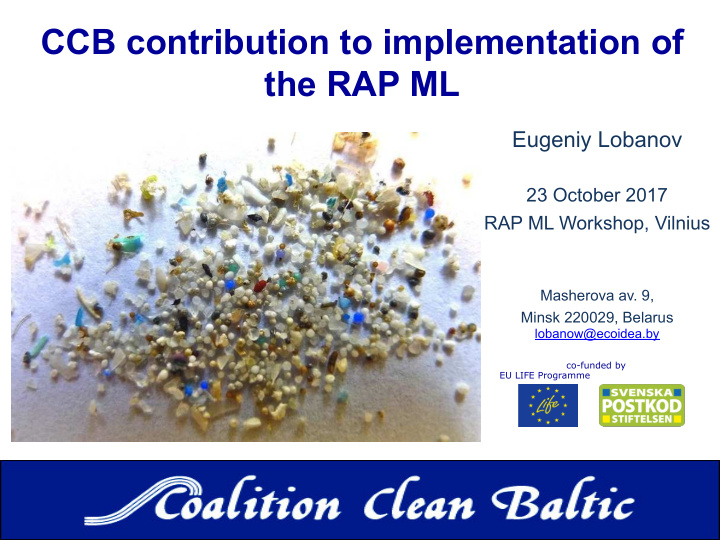



CCB contribution to implementation of the RAP ML Eugeniy Lobanov 23 October 2017 RAP ML Workshop, Vilnius Masherova av. 9, Minsk 220029, Belarus lobanow@ecoidea.by co-funded by EU LIFE Programme ¡
CCB Working Areas Water Protection in River Basin and Fisheries and Agriculture Wastewater Management Aquaculture Hazardous Substances Biodiversity and Nature and Marine Litter Conservation co-funded by EU LIFE Programme ¡ Sustainable Development Harmful Installations in Coastal and Marine and Maritime Transport Areas
CCB’s targets on Marine Litter • Ban microplastics from consumer care products by law • Set up EU marine litter reduction target of 50% by 2025 • Fully implement HELCOM Regional Action Plan on Marine Litter , applying innovative and radical reduction strategies • Facilitate and support BSR NGOs in awareness raising and knowledge exchange on marine litter in the Baltic Sea co-funded by EU LIFE Programme ¡
CCB’s inputs to HELCOM RAP ML RAP ML CCB Work Programme Compilation of information on • Overview of products personal care products contributing to microplastic containing microbeads pollution Promotion of public monitoring • Exchange of experiences on tools – MLW beach clean-up National awareness raising and • Raising awareness on ML media outreach • Addressing producers of personal care • Dialogue with industry re. ecodesign products and other sources (microbeads, packaging) • Evaluation of effectiveness of wetlands • Promote additional techniques at in trapping micropollutants WWTPs • Developing and testing public • Improvement of stormwater monitoring methods to evaluate riverine management inputs of litter, including microplastics • Seek cooperation with River Basin • Continue training and promotion of Commissions re. inputs of litter public monitoring tools • Continue awareness raising campaign co-funded by EU LIFE Programme ¡
Screening of riverine/ freshwater microplastic inputs • Simple methodology for detection of microplastic in rivers, streams, and other freshwater bodies has been developed and tested in in Latvia, Lithuania, Poland, Russia, and Belarus. co-funded by EU LIFE Programme ¡
Screening of riverine/freshwater microplastic inputs co-funded by EU LIFE Programme ¡
Prevention of microplastic pollution from storm- and wastewater discharges The “Guidance on concrete ways to reduce microplastic inputs from municipal stormwater and waste water discharges”, including (1) stormwater management implications in climate change conditions and (2) draft methodology for microplastic detection, has been finalized and published on CCB’s website. It was presented at various occasions and disseminated EU-wide. co-funded by EU LIFE Programme ¡
Review of information on other sources and pathways of microplastic pollution • Technical report on MP pollution originating from textiles and paints/coating has been published on CCB’s web-site, and will be used in public awareness. co-funded by EU LIFE Programme ¡
Public awareness and education on marine litter and microplastic pollution • Online training course on marine litter and microplastic pollution has been launched in Sept 2017; • CCB contributed to the Out-to- Sea Travelling Exhibition in Technical Museum of Stockholm. co-funded by EU LIFE Programme ¡
Public awareness and education on marine litter and microplastic pollution • Outreach materials, including in national languages have been produced and disseminated during various organized events. co-funded by EU LIFE Programme ¡
Thank ¡you ¡ ¡ for ¡your ¡ a,en.on! ¡ ¡ co-funded by www.ccb.se ¡ EU LIFE Programme ¡ www.ecoidea.by ¡ ¡ ¡
Recommend
More recommend